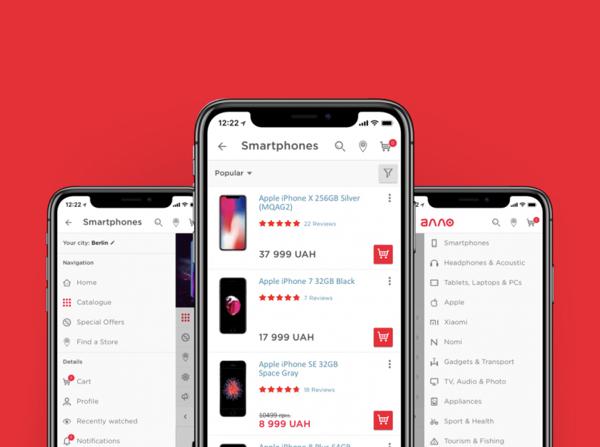How to Build an Online Grocery Shopping App: Features and Cost
Mobile apps for grocery shopping have been growing in popularity for years, but in 2020, this industry’s growth went through the roof. Traditional grocery chains started to develop and improve their grocery software to let customers order food and beverages remotely
Modern grocery apps, however, offer more than just online grocery shopping: they give businesses the opportunity to increase their sales, reach a new market of active mobile users, learn more about their customers, and make highly targeted offers that increase conversion rates and, consequently, revenue.
In this article, we’ll discuss how to start a grocery delivery service by creating a grocery shopping app for your business, whether it’s a small store or a large chain.
To start, let’s analyze the prospects of online grocery app development and see how welcoming the market is for new grocery shopping software.
Grocery shopping mobile apps: market overview
Grocery shopping is a $1.04 trillion market globally, and in 2020, the percentage of online grocery sales grew to 10.2% or $106 billion according to a study by Mercatus. Compare that to $34.4 billion in 2019. The pandemic has massively influenced the market, and according to Mercatus, by 2025, online grocery sales will double compared to 2020.
In this graph, you can compare the pre-COVID and post-COVID market:
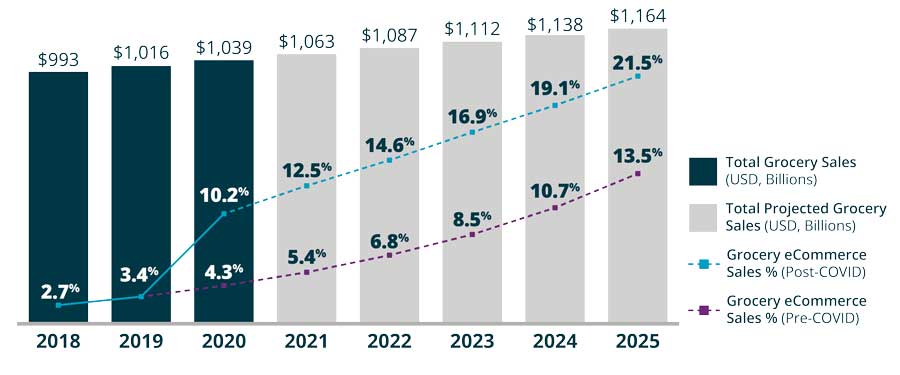
In the US, online grocery shopping is expected to grow from 34% of the grocery market at the beginning of 2020 to 55% to 66% in 2024 according to Business Insider Intelligence.
Mobile applications are the primary tool for online grocery shopping. At the beginning of April 2020, global downloads of grocery shopping apps reached 106 million a month. Walmart reported the highest number of downloads ever in April and took first and second places on the Google Play Store and Apple App Store respectively.
Another large player in the online shopping market, Amazon, has reported that its app downloads have increased by 20% since January 2020.
This spark in interest is obvious if you check Google Trends:
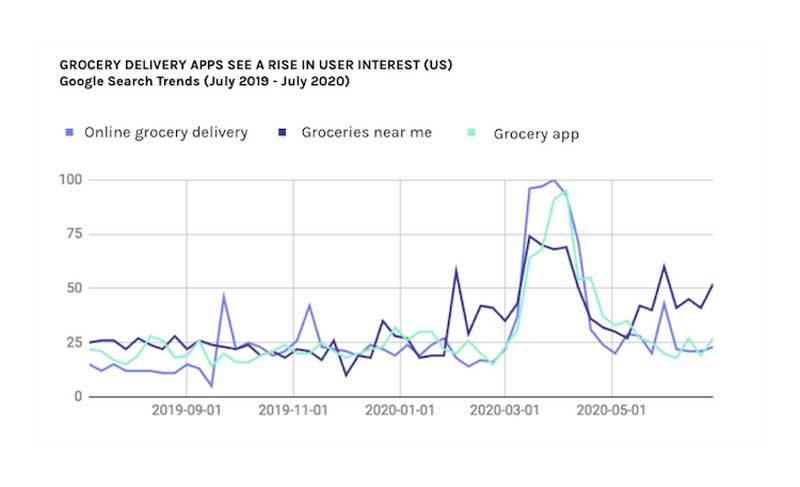
But what will happen after the pandemic? Will online grocery sales drop? Even after the COVID-19 pandemic is over, a large number of people will choose online grocery shopping as their primary strategy due to convenience and time savings.
In the US, online sales of food and beverages are projected to grow to $28 billion by 2022 according to eMarketer. With the pandemic, these numbers may be higher.
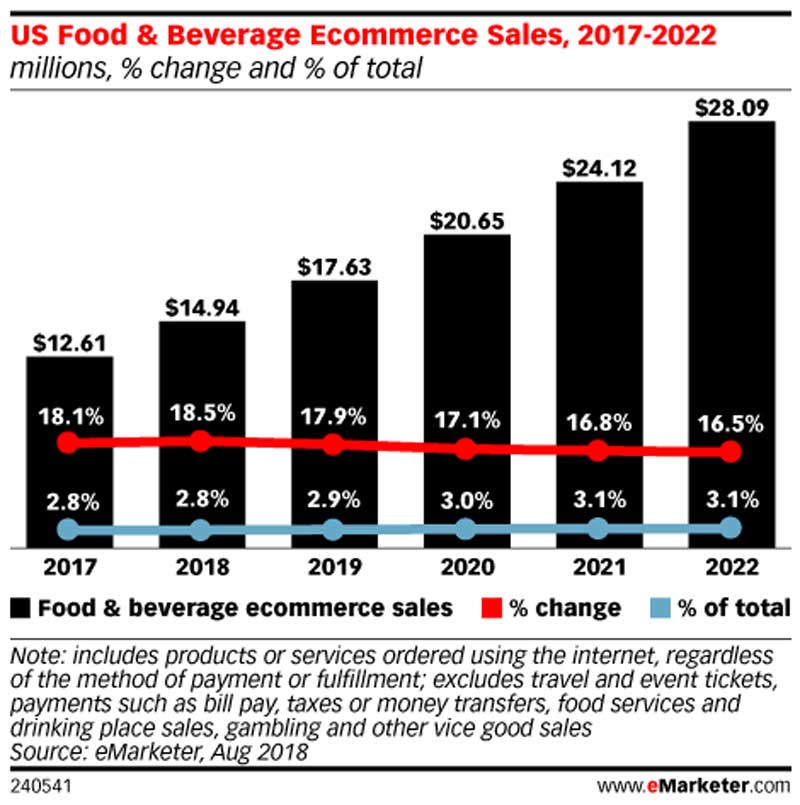
Types of grocery shopping apps
A grocery purchasing and delivery service requires at least two sides: vendors (suppliers) and customers. Sometimes, there are also couriers. Let’s examine the main types of grocery shopping apps based on who provides these services.
Small stores
Small stores usually create a grocery app to retain their existing customers and improve the in-store experience instead of to attract new customers. Small businesses tend to use out-of-the-box solutions for their mobile apps because of limited budgets and small feature sets that include listings and the ability to order delivery.
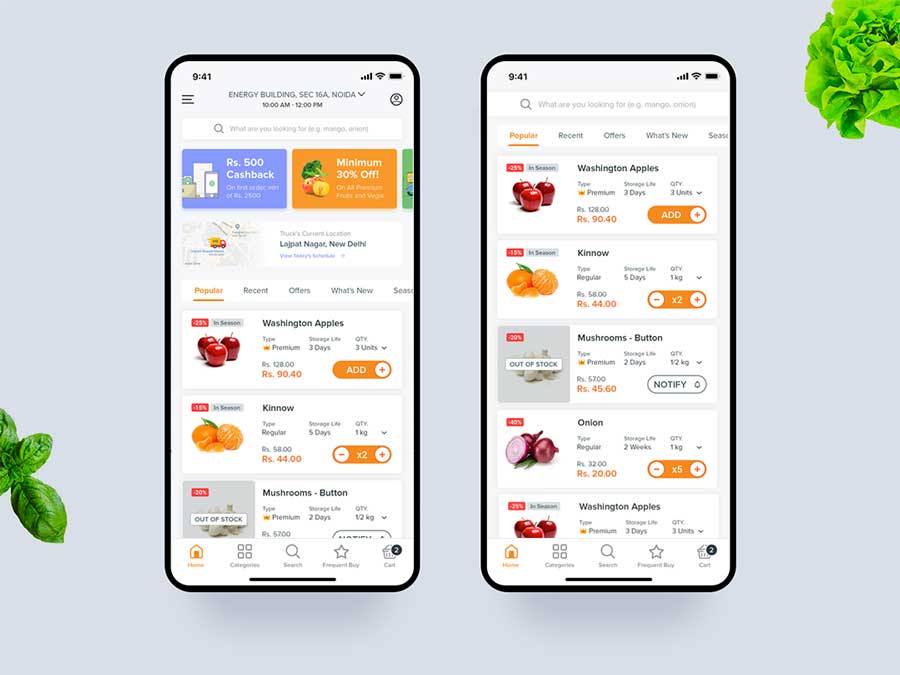
Large store chains
Applications for large grocery store networks tend to be feature-rich, offering listings, loyalty programs, online payments and orders, and various delivery options such as store pick-up from store or home delivery. Such applications also have geolocation features that allow customers to find the chain’s stores. Grocery chain apps collect information on purchases and customer locations and can send highly personalized notifications based on that information.
Multiple stores
Aggregator apps work as mediators between stores and buyers, allowing users to choose products from different stores in one place. Apps for aggregator marketplaces usually earn money by charging a fee for each order. In exchange, stores get an online presence and get perks such as marketing and access to a new audience.
Courier apps
Courier apps don’t represent a particular store or group of stores. Instead, they allow users to hire someone who will not only deliver goods from a grocery store but also pick and buy them. Instacart is one of the most popular examples of a courier app, and it’s based on the gig economy, and all its service providers are contractors.
When it comes to types of services, grocery shopping apps can be divided into these categories:
- Grocery delivery apps
- Price comparison platforms
- Shopper list apps
- Discount apps
In this article, I’ll be talking about creating a custom app for a grocery store or a supermarket. The feature set I’ll describe will be suitable for a chain of supermarkets, and depending on your business goals, you can cherry-pick the features you’ll need for your own retail app development.
If you have a small store and you’d like to create a simple software product, there are two options I’d recommend: using an off-the-shelf builder or creating a simple cross-platform app with Flutter.
Benefits of building a custom grocery shopping app
There are hundreds of off-the-shelf grocery shopping app solutions on the market that offer features like payment gateways, listings, and delivery functionality. However, such solutions are hard to customize and scale as your business grows.
An off-the-shelf solution has its benefits, such as instant access, low initial investment, and support. But what can a custom grocery delivery app development offer?
Customization
This is the most obvious benefit of any custom development: the ability to build exactly what you need for your business and scale or change your product in any way you want. Customization allows you to make your app unique and stand out from competitors with simpler and more generic mobile solutions.
With custom development, you can build exactly what you need for your business and scale or change your product in any way you want
When developing a custom application, you’re free from any restrictions. You can choose any design, payment gateway, and functionality.
Speed
A custom mobile app is often higher quality than an off-the-shelf solution because its architecture is designed specifically for your needs and it has no unnecessary parts.
If you want to save money for marketing, you can use cross-platform technologies like Flutter that have great performance. This will make your app work smoothly and let you bring the best service to your customers.
For your customers, speed is one of the biggest advantages of shopping in a mobile app over shopping offline. In a mobile application, customers don’t have to wait in line and carry the products home. A mobile app gives customers the opportunity to do everything online and get products delivered in as little as an hour.
Convenience
Being convenient should be the primary goal of your mobile product. Getting revenue as a result of this convenience should be the primary goal of your business. To make your software as convenient as possible, you need a smart grocery app UX design that will make the user journey as short and smooth as possible.
Custom mobile apps have more opportunities to provide a convenient user experience, as the UX designer can lean on your business goals and your brand when designing the user experience.
Quality and reliability
I’ve already mentioned quality as one of the benefits of a custom mobile app. A custom grocery app that’s developed by an experienced vendor will be more maintainable and perform better than any off-the-shelf solution because the architecture and technologies will suit the particular feature set.
You can never know what’s under the hood of your off-the-shelf app, and this can cause problems in the form of unpredictable downtime that you can’t do anything about.
A custom app is always under your control, as you can test its separate parts and minimize both security and performance risks.
Customer data
A custom grocery app can give you access to data about your customers that you could never attain without the app — data on the devices customers use, the products they buy at your store, their behavior, their habits, and their preferences. You can customize your analytics to your liking and collect data on how customers interact with your business through your app.
You can then use this data to personalize your offers.
Special offers and increased conversions
After you’ve collected data about your customers, you can target particular groups of customers with personalized offers, discounts, and promotions. Using algorithms, you can predict what products your customers are currently interested in, what makes them choose a particular product, and so on.
Personalized offers paired with push notifications can dramatically increase your revenue. Also, you can add loyalty programs to your application and allow customers to collect bonuses for each online order or by scanning an in-app QR code in your offline store.
Now let’s talk about the features you’ll need to make grocery shopping easy for your customers.
Must-have grocery shopping app features
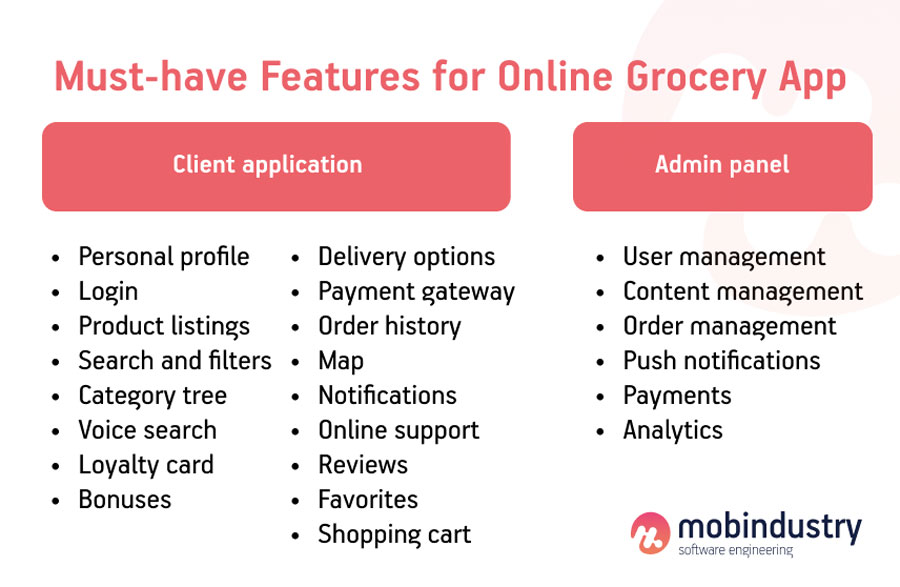
Client application
Personal profiles
A personal profile contains information about a user, including their name and favorite offline store.
Login and onboarding
Your customers should have multiple ways to register and log in to your app. It’s common practice to allow users to log in with an email address, phone number, or social media profile.
Onboarding offers a short tutorial on how to use your app. It’s optional, but it definitely helps users get to know your app and service.
Product listings
If you plan to offer delivery, you should definitely add product listings to your app so users can choose what they want to order. A product listing usually consists of a product name, pictures, and a rating.

Search and filters
To help your users find the products they want, add a search bar. The best practice is to make search predictive so users don’t have to completely type the name of a product.
Category tree
A category tree is another tool to make searching easier for your customers. A category tree allows users to search for products of a certain type without having to type a product name into the search bar.
Voice search
Voice search is a growing trend in ecommerce, with more and more people ordering products online using voice commands. Though it’s not a must-have feature, it can definitely enhance the user experience and make your product competitive.
Loyalty card
Make your service more convenient by adding a loyalty card to your application. Allow your customers to use this loyalty card in your offline stores and when making online orders. Loyalty cards can be displayed as barcodes or QR codes that your staff can scan in your offline store.
Bonuses and promotions
Make sure to show discounted products in your app. We advise you to place this information on the home screen so it’s the first thing your users see when they launch the app.
Favorites
Allow users to add products to their favorites if your product supports ordering products online. You can also notify users when products in their favorites are on sale.
Shopping cart
The shopping cart is the final step in your user’s journey, and it should show the products your user has decided to purchase along with the total price, taking into account all promotions and loyalty card bonuses.
Shopping carts are often abandoned, so we advise you to send automated notifications reminding users to complete their purchases.
Delivery options
Give your users different delivery options. Users might choose to pick up products from your store themselves, or choose home delivery. The delivery price should also be reflected in the shopping cart and at the checkout.
Payment gateway
Choose a payment gateway that has lots of payment options, or integrate several payment gateways, such as Braintree, Stripe, Google Pay, and Apple Pay. There are hundreds of payment gateways. Some are international; others are local and popular in particular countries or regions. Each payment gateway has its own fees and charges, so choose the most beneficial options for you.
Also, don’t forget to add a cash on delivery payment option.
Order history
A user’s order history shows all purchases the user has made in the app or in offline shops after scanning a loyalty card. You can also use information about previous orders to personalize your offers.
Map
Location-based features will be great for finding offline stores, delivering orders, and sending location-based push notifications. There are lots of maps you can integrate and customize to your liking. We usually advise Google Maps or Apple Maps depending on the app’s platform.
Notifications
Push notifications are the primary way to communicate with app users. Send them to promote offers, inform users about new products and discounts, and remind users of abandoned shopping carts.
If you want to connect your offline and online grocery business, you can also implement location-based push notifications
Online support
Let users connect with you and get support with your service. To automate online support, you can integrate a chatbot that can answer generic questions on products, delivery statuses, and so on.
Reviews
If you plan to create a marketplace for grocery stores, it’s vital to add reviews. Even if you’re building an app just for your store, however, you can still add functionality so users can leave reviews.
Along with a grocery shopping app, you’ll need to develop an admin panel where you can control your application and manage your users and in-app content. Let’s see what features you’ll need for a grocery app admin panel.
Admin panel features
User management
An admin should be able to see information about users, including their logins and passwords.
Content management
In the admin panel, you should be able to change content in your app: add new products, edit descriptions, change photos and prices, and so on.
Order management
You should be able to see the current orders, their statuses, and all order details.
Push notifications
In your notification center, you should be able to create and send notifications to all users or particular groups of users. You should also be able to automate push notifications: for example, to send a notification after two days of inactivity.
Payments
You should be able to see all payments your customers make through your app and see the most popular payment methods.
Analytics
Analytics can allow you to learn everything about how your app is performing from both the technical and business perspectives. See how many monthly, weekly, and daily users you have, how they behave in your app, what features they use most, and what products they buy most often. Analytics will also give you insights on the devices your users most commonly use, your app’s performance, and so on.
Choosing a tech stack for your grocery shopping app
The backend of the app
The backend of your grocery shopping application is the backbone of whole system. It’s responsible for the business logic, data storage, and communication between the server and the client app. For the backend of a grocery app, you can use languages like JavaScript, Python, or PHP. Each language has its own framework, so you’ll need to choose it as well.
Framework
A framework connects your application’s interface with a database according to your business logic. It processes requests, addresses, and more.
A framework is a set of libraries that help developers easily integrate and set up:
- Payment gateways
- Third-party services like maps
- Search logic and filters
- Admin panels
- Sorting logic
- Business logic
Your choice of framework depends on the programming language you use. Here are some of the options:
PHP:
- Symfony
- Laravel
- Zend
There are more PHP frameworks; however, these three are the most advanced: they have out-of-the-box libraries for admin panels and all other functionality. Out of the three, I’d choose Symfony for a grocery delivery startup.
Python
- Django
- Flask
Both Django and Flask are suitable for a grocery delivery business; however, Django has one serious advantage: it has its own admin panel. Unlike Symfony, it doesn’t require the installation of an additional open-source library. This makes Django convenient for admin panel development.
Ruby
- Ruby on Rails
Ruby on Rails has lots of ready solutions, and developers often choose it to create backends for different types of products. However, I would recommend a Python or PHP framework, as Ruby has recently started to lose popularity. Each year, the community becomes smaller and smaller.
This can cause problems in the future, as the less community support there is, the harder it is to keep a framework up to date and find new and better technical solutions for your business.
Database
A database is responsible for organizing and storing data. The most popular choices are:
- MongoDB
- MySQL
- PostgreSQL
After you scale your project and your server starts receiving more and more requests, you can pair your database with a caching tool like Redis or Memcached. These tools store data in RAM, helping you unload the server and remove recurrent requests.
Server
For cloud servers my suggestions are:
- DigitalOcean Cloud Services
- Amazon Web Services
- Linode
- Vultr
- Microsoft Azure
To process server requests, I advise this web server software:
- Apache HTTP Server
- Nginx
Admin panel
After you’ve chosen your framework and the programming language for your grocery shopping app, you can start developing an admin panel. The tools for your admin panel development depend on the framework. I’ll give you an example of Symfony, which is a PHP framework.
If you use Symfony, you have three options for your admin panel:
- Easy Admin
- API Platform admin
- Sonata Admin
Easy Admin is a great tool for creating clear and functional admin panels with all necessary features. It’s compatible with Symfony only. API Platform Admin offers a ready React UI component set for your frontend, and it’s connected to Symfony via an API.
Consult with a web developer who can assess your project and business needs to help you choose the right tool.
If you choose a Django framework, you won’t need to integrate a library to create an admin panel.
To sum up, these are the set of technologies I advise for a backend and admin panel:
| System component | Technologies |
| Server | DigitalOcean, Cloud Services, Amazon Web Services, LinodeVultr, Microsoft Azure |
| Web server software | Apache HTTP ServerNginx |
| Programming language | PHP, Python |
| Framework | Symfony, Django |
| Database | MongoDB, MySQL, PostgreSQL |
| Caching tool | Redis, Memcached |
| Mobile app | Swift, Kotlin, Flutter, React Native |
App Development for Android/iOS
For a client app, you’ll need to choose either native or cross-platform technologies. A native app will be of a higher quality, but if you need an app for both Android and iOS, you’ll need two apps written in Kotlin or Swift.
For a grocery shopping application, however, the possibilities of good cross-platform frameworks will be more than enough. I recommend Flutter, however, you can also use React Native for your application as well.
Top 3 applications for grocery shoppers
When developing an app, you want to look at the industry leaders and take inspiration from their products. Let’s review the three most popular grocery shopping apps.
Walmart App
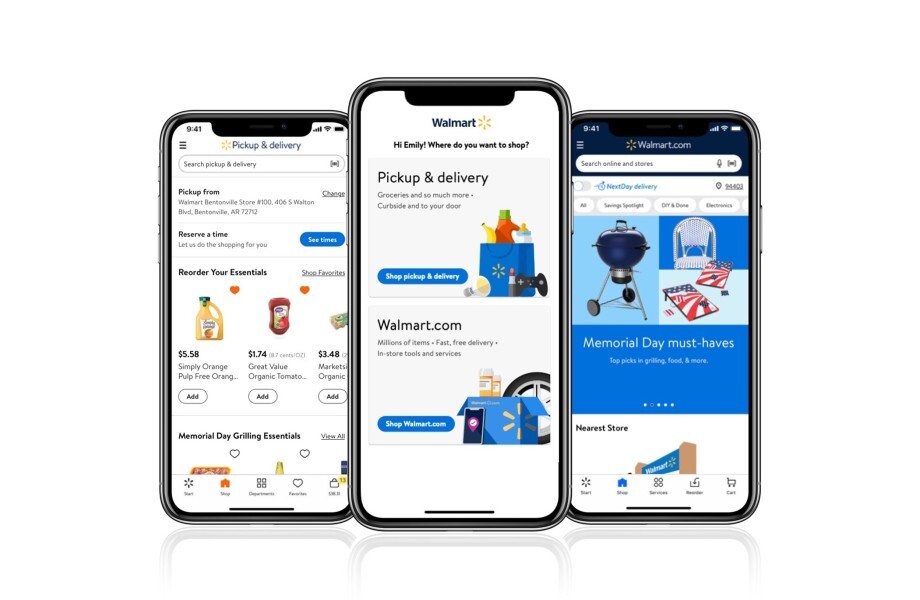
Walmart created an application to allow their customers to shop online. This is considered the best app for ordering groceries by many of its users. With this app, customers can make orders, get notifications on the latest discounts and promotions, and choose delivery options including store pick-up. Customers can also link their Walmart cards to the app and pay by scanning a barcode.
The Walmart app allows users to create shopping lists, find the nearest stores, and check pricing. This app is available on both Android and iOS.
Happy Fresh
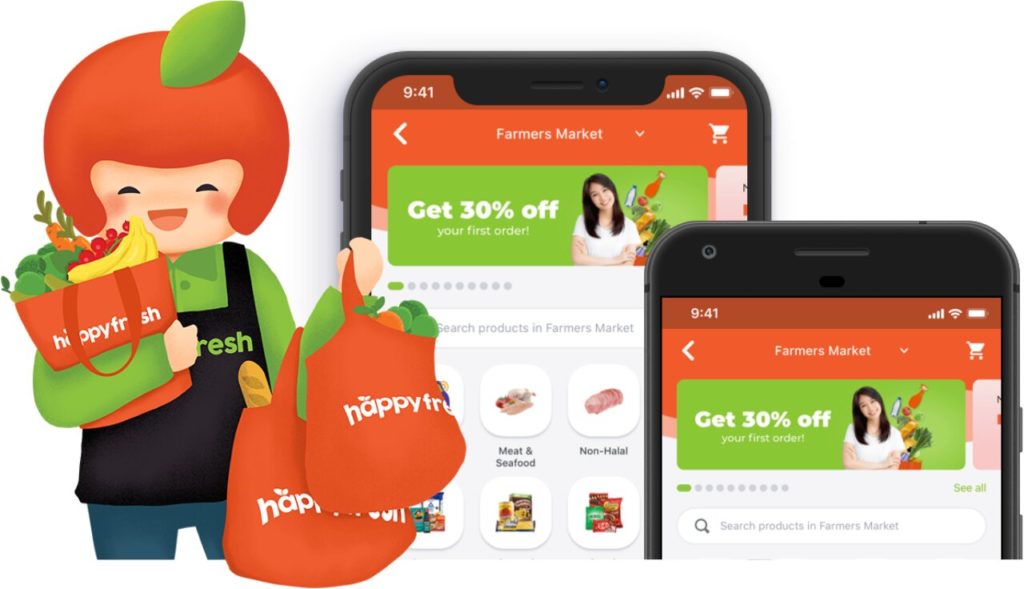
Happy Fresh is a large grocery marketplace that unites over 15 supermarket chains in Asia. It offers unified product listings so users can order from different supermarkets.
Happy Fresh provides special promotions, vouchers, and promo codes that are updated daily. Moreover, free delivery is often available. Happy Fresh allows customers to pay with credit and debit cards, e-wallets, and cash, so they have lots of options to choose from.
Amazon Prime Now
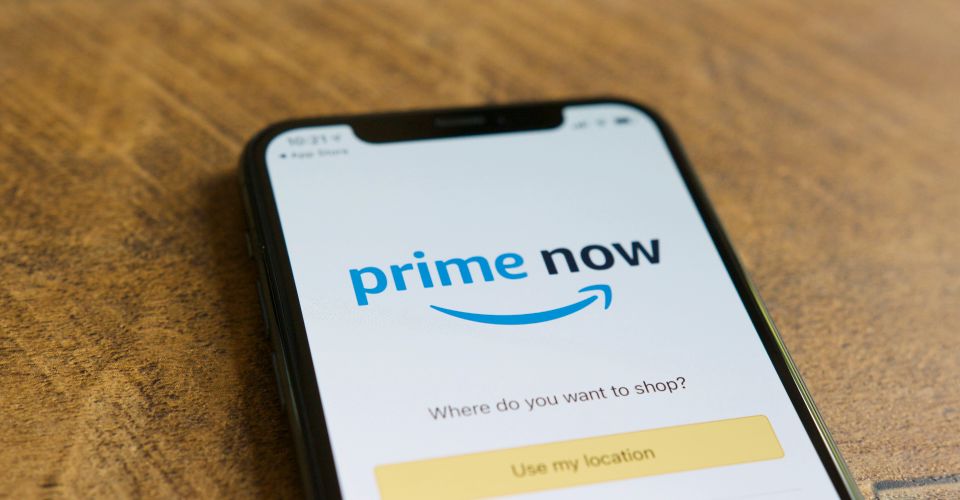
Amazon is the largest ecommerce giant in the world, and it has its own grocery delivery and shopping app. Amazon Prime Now offers one- to two-hour delivery that few shops can compete with and allows customers to choose from thousands of products. Essentially, it’s a marketplace that offers delivery from local grocery stores and select markets.
How much does it cost to create a grocery shopping app?
The grocery app development cost can vary a lot depending on these factors:
- App size
- Functionality
- Platforms
- Technology stack
- Design complexity
- Hourly rate of the grocery mobile app developer
The app’s feature set and the hourly rate of developers are the two most influential factors that form the price of online grocery shopping app development. The hourly rate often depends on where your grocery delivery app development company is situated. Eastern Europe has a relatively low cost of living, which is why the price difference between developing in the US and in Ukraine can be fourfold while achieving the same quality.
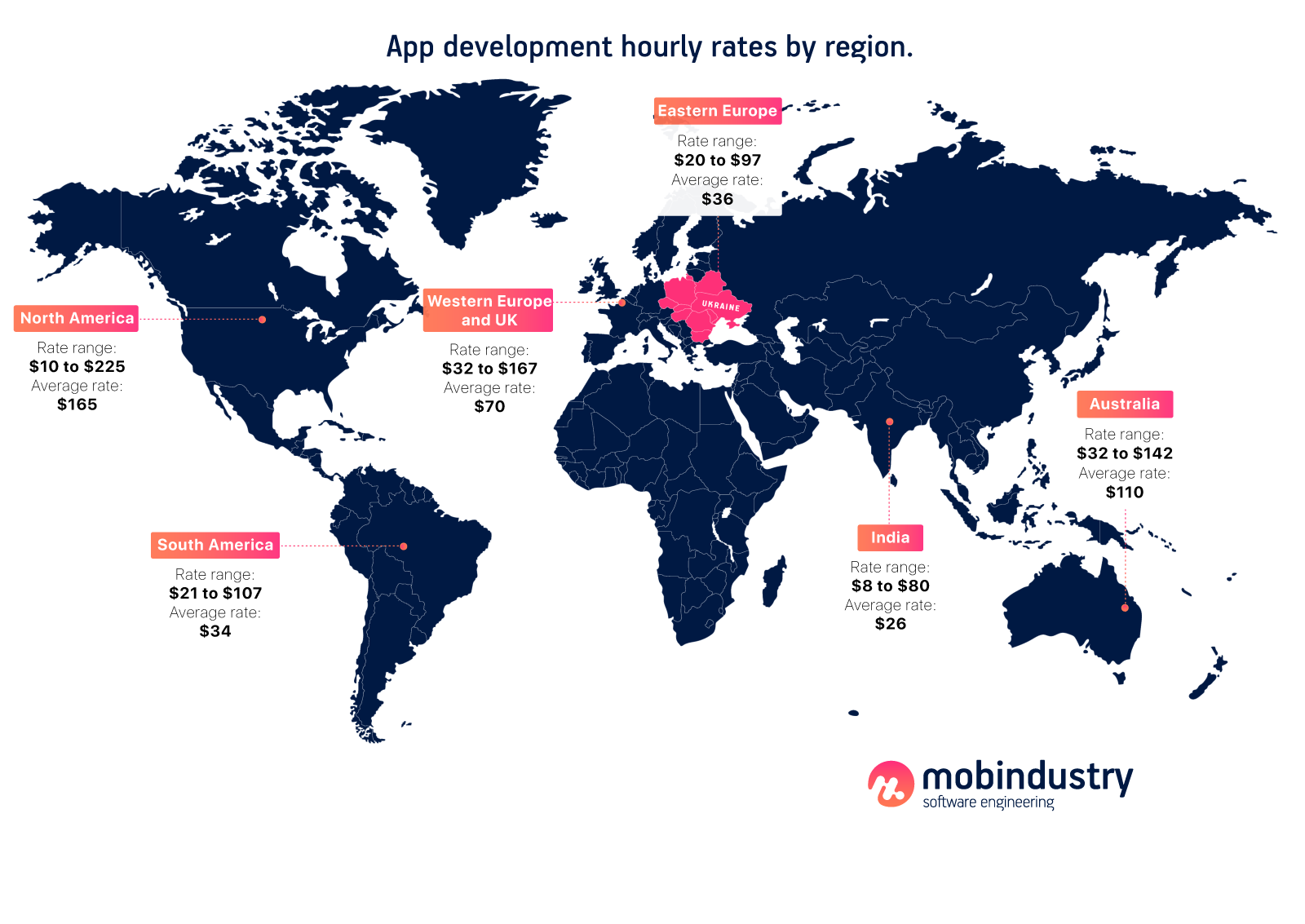
A full-fledged grocery shopping app can cost from $10,000 to $80,000 depending on your grocery app features. You should also take additional costs into account for third-party solutions like payment gateways or maps along with ongoing maintenance and updates.
Final thoughts
Grocery shopping applications are growing in popularity due to the coronavirus pandemic, but after it’s over, many customers will still opt to buy groceries online because of the convenience. Now it’s a great time for starting a grocery delivery service business. Moreover, you can give users additional value in your store by allowing them to keep their loyalty cards in their smartphones.
In this article, we discussed how to start an online grocery delivery business and approach grocery store app development.
Many customers will still opt to buy groceries online because of the convenience after the pandemic
To make your own grocery delivery app, you need to have a clear understanding of your business goals and pay close attention to the user experience. We also advise you to invest in marketing. To save money for promoting your app after the release, you can outsource your on-demand grocery delivery app development to offshore professionals.
If you plan to start your own grocery delivery service and want to find out how much it costs to develop a grocery shopping app or what features you’ll need to maximize customer satisfaction and revenue, don’t hesitate to contact us. We have vast experience developing ecommerce applications and websites for both small shops and large retailers.



